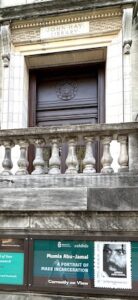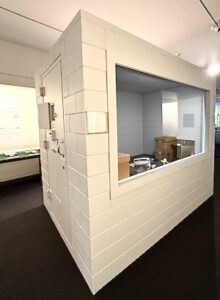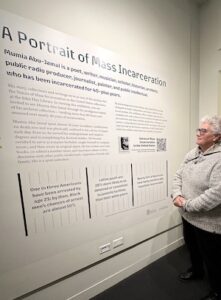Providence, RI – The decades long efforts to erode the public credibility of U.S. political prisoner Mumia Abu-Jamal sustained a substantial setback recently at an unlikely location: an Ivy League university.
Brown University, the Ivy League institution located in Providence, Rhode Island, opened a unique exhibition on September 28, 2023, at its John Hay Library, that features the life’s works of Abu-Jamal, the Philadelphia-born journalist now serving a life-without-parole sentence.

Abu-Jamal’s spent over 40 years inside of Pennsylvania prison cells due to his controversial 1982 conviction for fatally shooting a Philadelphia policeman.
From inside death row isolation cells, Abu-Jamal wrote over a half dozen books, penned thousands of perceptive commentaries, graduated college, obtained a master’s degree, gained a paralegal certificate, wrote poems, authored sheet music, created art works, and learned three foreign languages.
Last year Brown University’s John Hay Library obtained thousands of items Abu-Jamal had accumulated, mainly during 25+-years on Death Row, that include legal documents, personal correspondences, visitor logs, art works, and even a broken pair of glasses.
Of long term importance, the Hay Library is digitizing items in its Abu-Jamal collection so scholars, students, and others can have access to the items.
Having these items in that Library’s permanent collection plus making them readily available to the public through the worldwide web elevates the availability of information about the struggles for justice by-&-for Abu-Jamal, who is arguably the most recognized and respected inmate in the world.
“Having this Ivy League pedigree signals to the world to study [Abu-Jamal] not just as a ‘cop killer’ but as a human being,” Dr. Todd Steven Burroughs, a consultant on the Hay Library’s Abu-Jamal Exhibition, said.
Dr. Burroughs, who’s studied Abu-Jamal’s journalism, activism, and life for nearly thirty-years, said, “If anyone doubts [Abu-Jamal] is not a world historical figure, they need to come see this Exhibition during the next year.”
That Abu-Jamal exhibition includes an unusual, imposing item that sits in the middle of one of the Exhibition’s rooms inside the Hay Library. That item is a full-sized replica of a Death Row prison cell, complete with wall mounted bunk, a metal table and chair along with the combined metal toilet-sink unit. The replica contains a window to enable looking inside the cell. (Prison cells do not have such windows.)

Abu-Jamal’s incarceration includes over 25-years living inside a 6×9-foot Death Row cell, under persistent threat of execution.
Court rulings that changed Abu-Jamal’s death sentence into life in prison without parole, have consistently rejected conclusive evidence of his innocence. Those judicial rejections of factual evidence of innocence plus dismissal of violations of Abu-Jamal’s legal rights are key components driving many around the world to deem him a political prisoner.
The volume of writings Abu-Jamal completed while on Death Row shows the strength of Abu-Jamal’s spirit and his power to create, Dr. Christopher West, Curator for the Black Diaspora at the John Hay Library, said during remarks at the formal opening of the Abu-Jamal exhibition. (Abu-Jamal’s creative output while on Death Row far exceeded the output of most non-incarcerated journalists during a comparable period.)
For Dr. West, American society needs to recognize the “inhumanity of putting thousands of people into” solitary confinement, where inmates spend 22-hours-per day locked, isolated, in small cells for years. West referenced this penal practice as not the best way for “a society to operate.”
The opening of the Exhibition – entitled “Mumia Abu-Jamal: A Portrait of Mass Incarceration” – was part of a three-day symposium on mass incarceration at Brown. The Abu-Jamal collection is a focal point of a new archive at the John Hay Library containing papers of incarcerated persons.
Amanda Strauss, Director of the John Hay Library, stressed the importance of the new incarcerated persons archive during her remarks at the opening of the Abu-Jamal Exhibition.
“We have to tell the story of those who have been voiceless,” Strauss said.
Interestingly, Abu-Jamal, during his journalism work before incarceration, earned the title ‘Voice of the Voiceless’ due to his coverage of the poor and powerless whose concerns were consistently excluded from most news media attention.
Brown University alum, Dr. Johanna Fernandez, a history professor in NYC and a leading activist for Abu-Jamal’s release, donated the 97 boxes of Abu-Jamal items to Brown in 2022.
The night before the Exhibition’s formal opening, Fernandez participated in a panel discussion about Abu-Jamal and mass incarceration along with iconic activist/scholar Angela Davis and human rights/Abu-Jamal activist in France, Julia Wright, who appeared via Zoom from Paris. Wright’s father is the late, fabled African American author Richard Wright.
Sophie Butcher, a senior at Brown from Australia who worked on the Hay Library’s Abu-Jamal project, described her experience as “living inside Mumia’s head.” Butcher said working on this project convinced her that Abu-Jamal is a “brilliant man.” Butcher said she was awed when she finally heard Abu-Jamal’s voice – live – for the first time when he phoned into that panel event with Fernandez and Davis.
Efforts to silence and otherwise suppress Abu-Jamal are constant elements of his decade’s long incarceration.
During the late 1980s an example of suppression was prison authorities’ denying Abu-Jamal access to a newspaper with socialist content. Authorities’ speciously claimed Abu-Jamal’s receipt of that newspaper presented a security risk for the entire prison despite that fact that Abu-Jamal was isolated in a death row cell with no access to any other inmates. At that time, inmates had prison approval to receive white-racist and pornographic publications. (Racism and rapes create security risks in prisons.)
In the mid-1990s an effort to silence Abu-Jamal through attacking publication of a book featuring his writings led to a gross violation of his legal rights. During that effort, initiated by Philadelphia’s anti-Abu-Jamal police union, Pa prison authorities unlawfully opened Abu-Jamal’s mail with his lawyers. Prison authorities sent those confidential legal strategy communications to the office of the then Pa Governor. That Governor utilized those unlawfully obtained legal communications to issue an unlawful death warrant for Abu-Jamal that helped sabotage his pivotal appeal hearing in August 1995. Courts – state & federal – have blithely dismissed that Governor’s disruptive and unlawful intervention.
In 2014, the Pa State Legislature passed a measure dubbed the “Silencing Act” initiated by conservatives specifically to suppress Abu-Jamal. A federal judge later voided that Act as unconstitutional.
Phillip “Rock” Lester, a panel participant during Brown’s mass incarceration symposium, said his first exposure to Abu-Jamal was when he was imprisoned. This former L.A. gang member who now works on reentry and prison reform in L.A., said reading Abu-Jamal’s book on jail house lawyers while imprisoned was informative and inspirational.
“Mumia is a leader, an educator and a transformative person who is being purposefully suppressed,” Lester said, terming the exhibition on Abu-Jamal, “huge.”
The scores of persons who attended the Exhibition’s opening included Noelle Hanrahan, the founder of Prison Radio and the person who has produced Abu-Jamal’s broadcast commentaries for decades.

Hanrahan said if the Exhibition inspires better understandings about the depths of systemic racism and can accelerate commitments to work for Abu-Jamal’s freedom then, “this will be worthwhile.”
